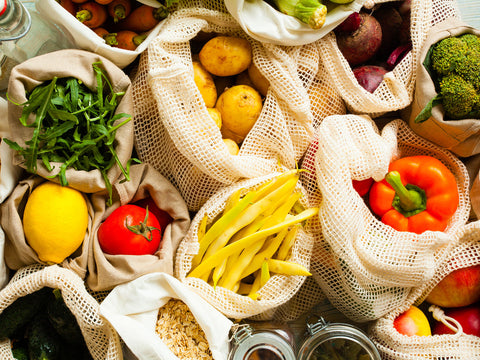We often find ourselves in bustling grocery stores, inundated by colorful displays of fruits and vegetables year-round. In our quest for variety and convenience, the concept of eating seasonally seems to have been overshadowed.
At its core, seasonal eating revolves around consuming fresh food based on its availability during specific times of the year. Different fruits, vegetables, and other produce have their moment to shine—a period when they are at the pinnacle of freshness, flavor, and nutritional value. By aligning our diets with this natural cycle and understanding the nuances of seasonal availability, not only do we enhance our culinary experience but also reap numerous health benefits.
This approach is healthy and delicious, but it’s also environmentally sustainable and supports local farmers and the community. It is a practice deeply rooted in the connection between local climate patterns and the harvest calendar.
Perfectly-timed flavor and nutrition
Imagine sinking your teeth into a juicy, sun-ripened peach or savoring the earthy sweetness of a freshly harvested carrot—the explosion of flavors is a sensory delight and a sign of abundance in essential vitamins and minerals.
One of the primary advantages of indulging in seasonal produce is the unparalleled freshness and flavor it brings to our table. Fruits and vegetables grown in their natural climates and given more opportunity to sun-ripen during their optimal growth and maturity period tend to taste better and be more nutritious. As they ripen, bees and other pollinators that are active in their natural rhythms help bring out the best in these fresh ingredients.

During the summer months, strawberries become juicier, redder, and sweeter. Honeydew melons are no longer crisp and watery but instead, taste like fragrant honeyed melons. Vegetables such as green beans, carrots, and summer squash become bolder and more flavorful. Shishito peppers (a tangy and vegetal bar snack that pairs perfectly with cocktails when blistered and tossed with lemon juice and salt) are firmer and more delicious in the summertime.
Choosing to purchase produce according to its season not only leads to bigger, bolder flavors but also ensures that the plants are within their window of optimal growth and maturity. This means that the ingredients are packed with good-for-you nutrients that your body will appreciate.
Eating seasonally provides our body with the nutrients it needs at specific times of the year. For instance, in colder climates, winter brings an abundance of citrus fruits, packed with immune-boosting vitamin C, just when the cold—and accompanying flu season—peaks. In the summer, water-rich fruits like watermelon and berries help keep us hydrated in the sweltering heat. The balance of nutrients in seasonal produce complements the nutritional demands of each season, offering a potent dose of health-boosting goodness with every bite.
Supporting local ecosystems and building communities
Choosing to eat seasonally often means supporting local farmers and agriculture. As we savor the succulence of a ripe tomato or the crispness of freshly picked living lettuce, we are not only treating our taste buds but also contributing to the sustainability of local ecosystems.
Seasonal and local food is not just fresher and more flavorful, it is also more affordable. When produce is in season, it is abundant and the prices are lower. Local food supports small-scale growers and producers, which helps to build vibrant local economies. Seasonal produce is also more likely to be sourced locally, reducing the carbon footprint associated with long-haul transportation. Moreover, seasonal crops are less reliant on artificial enhancements and pesticides, contributing to a more sustainable and eco-friendly agricultural system.
All these promote a closer connection between consumers and local farmers, fostering a sense of community.
Variety and culinary creativity
Embracing seasonal eating introduces an element of variety into our diet. Each season offers a new plate of colors, flavors, and textures. This variety not only keeps our meals exciting but also ensures a diverse intake of nutrients.
Seasonal ingredients challenge us to get creative in the kitchen, experimenting with recipes that celebrate the unique attributes of each fruit and vegetable. In summer, we can enjoy a bounty of fresh produce like tomatoes, cucumbers, and zucchini. These ingredients can be used to create refreshing salads, light pasta dishes, and flavorful kebabs. Sweet and juicy fruits like watermelons, peaches, and cherries can also be used to create refreshing summer treats like sorbets, granitas, and ice creams.

Incorporating fresh, seasonal ingredients in cocktails also elevates your drink game to the next level. The sweet, tart, and tangy flavors of seasonal fruits like blueberries, watermelons, and peaches can add a refreshing twist to classic cocktails. Even bananas, a seemingly year-round fruit, take on a new dimension when enjoyed at their peak. Use ripe bananas to create a creamy, tropical base for a summer daiquiri, bursting with full-bodied flavor. Adding a handful of fresh herbs like basil, mint, or rosemary can also infuse the drink with an aromatic flavor, making each sip a delightful experience.
Veggies like cabbage, broccoli, and cauliflower are at best during cooler months making it a great addition to soups, salads, and stir-fried dishes. Summer veggies like squash and okra are not only packed with nutritional value but can also add a beautiful visual appeal to your dish. Bell peppers, celery, and bananas can also add a burst of fruity, tangy, and full-bodied flavors when used in their prime season.
Prioritizing the quality and freshness of seasonal ingredients is the key to unlocking a world of flavor possibilities. Next time you whip up a drink or craft a special dish, consider what's in season and let your creativity flow with it. Freshness isn't just a buzzword; it's the secret ingredient that makes every dish and drink exceptional.
The holistic approach to wellness
Eating seasonally is a holistic approach to wellness that nourishes both body and soul. Connecting with the natural rhythm of the seasons fosters a sense of mindfulness about the food we consume. It encourages us to appreciate the cyclical nature of life and the interconnectedness between our bodies and the environment.
The benefits of eating in-season extend far beyond the tastes and aromas accompanying each harvest. It is a lifestyle choice that embraces the wisdom of nature, nourishing not just our bodies but our communities and the planet.
Embracing seasonal eating is easier than we might think. Start by familiarizing yourself with the fruits and vegetables that are in season in your area each month.
Visit Joel’s Place to access fresh, locally grown produce. Get creative in the kitchen by trying new recipes that highlight seasonal ingredients, and let each bite celebrate nature's goodness!





